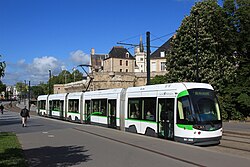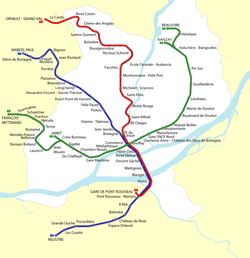Nantes Tramway
 |
|||
| Overview | |||
|---|---|---|---|
| Native name | Tramway de Nantes | ||
| Locale | Nantes, Pays de la Loire, France | ||
| Transit type | Tram | ||
| Number of lines | 3 | ||
| Number of stations | 83 | ||
| Daily ridership | 274,300 (2012) | ||
| Operation | |||
| Began operation | 1985 | ||
| Operator(s) | Semitan | ||
| Technical | |||
| System length | 44.3 km (27.5 mi) | ||
| Track gauge | 1,435 mm (4 ft 8 1⁄2 in) | ||
|
|||
The Nantes tramway (French: Tramway de Nantes) is a tramway system operating in the city of Nantes in Pays de la Loire, France. The first tramway in Nantes opened in 1879 and closed in 1958 due to bombing damage during World War II, while the present tramway was re-introduced to the city in 1985.
The first tramway in Nantes was notable for its use of compressed air propulsion pioneering this technology. In the 1980s, Nantes became the first city in Europe to re-introduce the present tramway which is notable as the first modern 'new generation' tramway to be built, reversing the trend of tramway closures that had been going on since the middle of the 20th century and becoming the first in a wave of tramways built from scratch in France and the rest of Europe.
The current Nantes tramway network consists of three lines, is 43-kilometre (27 mi) and serves 83 stations. It is operated by Semitan (commercially known as TAN), the operator of Nantes public transport network.
The history of the tramway in Nantes began on 13 December 1879 with the opening of the first line. Service was provided using standard gauge tramcars propelled by compressed air, using the Mekarski system. The cars stored the compressed air in steel cylinders, and were periodically topped up with air and steam (used to heat the compressed air) at a pair of recharging stations. The later Nantes cars operated at 840 psi (5,800 kPa).
The first line constructed was just over 6 km (3.7 mi) long and was a mostly level route operating east-west along the quays of the River Loire. The initial fleet comprised 22 trams, 2 locomotives and four open top trailers. A second line, running north-south and crossing both the original line and the River Loire was opened in 1888.
Further extensions, together with a third line along the banks of the River Erdre, brought the length of the system to 39 km (24 mi) by 1910. By then the fleet had grown to 94 trams, 3 locomotives and 10 open top trailers, and was carrying 12 million passengers per year. By this stage compressed air trams were seen as old-fashioned, and it was decided to electrify the system. Replacement began in 1913, and the last compressed air tram ran in 1917.
...
Wikipedia

